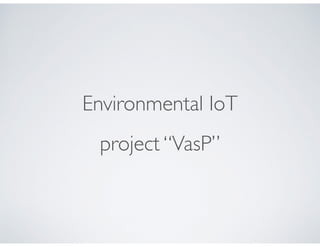Environmental IoT "VasP": Environmental sensing system using business vehicle
- 2. LETŌĆÖS AVOID AIR POLLUTION FORYOUR HEALTH we can do it with ŌĆ£VasPŌĆØ
- 4. imagineŌĆ” YouŌĆÖre plaining to play outside with your children in holiday
- 5. DANGER! DANGER! DANGER! DANGER! Then, you ’¼ünd the air monitoring stations show like this ŌĆ” What will you do? Are you staying at home? Are you going outside without any careŌĆ”?
- 6. PLEASE REMEMBER, ŌĆ£AIR POLLUTION CAN KILL PEOPLEŌĆØ
- 7. 1.6 million people per year died by Air Pollution in China 17% of whole death
- 8. how about in United States? ŌĆó 300,000/year : Obesity related deaths ŌĆó 101,000/year : Deaths due to lack of health care ŌĆó 88,000/year :Air pollution related deaths (reported by US EPA) ŌĆó 16,500/year : murders ŌĆó 4,300/year : pedestrians killed by automobiles 5% of whole death Is it small? or big?
- 9. +27% +10ppb ŌĆ£Lung cancer riskŌĆØ per ŌĆ£SO2 densityŌĆØ reported by Japanese Ministry of the Environment in 2008 researched over 10 year in 3 capital cities *10 ppb = 0.0000001%
- 10. Yearly average of PM2.5’╝Ü12╬╝g/m3 ŌåÆ 13╬╝g/m3 Number of Asthma patients’╝Ü46,000 ŌåÆ 140,000 Expectation reported by US EPA
- 11. We already had data accumulationŌĆ” Why such less awareness? Ōåō Shortage of the data resolution We donŌĆÖt know actual situation ŌĆ£right here, right thereŌĆØ
- 12. DISTRIBUTION OF CURRENT MONITORING STATIONS If the place taking over 1 hour driving from San Francisco City is 30% less of lung cancer risk ŌĆ”.Will you go there with your children just for playing at the park?
- 13. high-resolution mapping produced byVasP max 4.7ppm = 4700ppb difference ŌåÆ lung cancer risk about x100 not 100% up , 100 times! This is the value of ŌĆ£micro environmental informationŌĆØ marina near 101 Now, you can choose where you play! *less than 1 mile between 2 places
- 14. what is ŌĆ£VasPŌĆØ <MISSION> gather and provide ŌĆ£micro environmental informationŌĆØ all over the Earth * Vehicle as Probe =VasP
- 15. VasP unit battery mobile network sensors GPS * Vehicle as Probe =VasP
- 16. J-POP SUMMIT REVIEW 8th - 9th Aug. ŌĆÖ15 @Fort Mason Center in San Francisco
- 17. EXHIBITION gathered CO, CO2, NO2, Ozone, SO2, temperature, humidity, pressure, noise, UV, ambient light by bicycles mapped each data on web application
- 18. LRI = LIVING RISK INDEX our original index evaluating air pollution level connected with death and disease risk we knew mission area is better than market for living, but itŌĆÖs shown as difference of ŌĆ£living riskŌĆØŌĆ” the behavior of consumers could be changed market mission
- 19. MAJOR FEEDBACKS ŌĆó Recommendation to measure PM2.5 and radiation (and pollen) ŌĆó Lower awareness of environmental issues in SF (where is the best place?) ŌĆó Correlations between multiple factors might make next innovation (nobody tried) Mr. Furukawa (former president of Microsoft Japan) Mr. Sugano (data scientist)
- 20. BUSINESS MODEL
- 21. make pro’¼üt in each directions BUSINESS STRATEGY vehicle operators VasP government /business/ consumer data $ sensor unit $ services data services
- 22. TRACTION
- 23. COLLABORATION #1 ŌĆ£SimularityŌĆØ correlation Census data withVasP data Startup company in Richmond City
- 24. COLLABORATION #1 ŌĆ£SimularityŌĆØ we won the competition of Industrial Hackathon in ŌĆ£Meeting of MindŌĆØ Day1 Day2 Judges: Qualcomm, Cisco, Microsoft, Richmond City
- 25. TEAM https://www.linkedin.com/pub/yuichiro-kuzuryu-kuz/38/928/27b yuichiro ŌĆ£kuzŌĆØ kuzuryu master degree of electrical engineering atTokyo Institute ofTechnology in Japan YAMAHA Corp. 8.5 yrs electrical engineer, project manager and product producer Miselu Inc. (startup company in SiliconValley) 3.5yrs hardware architect, director of engineering YAMAHA Motor US 0.5yrs hardware engineer embedded software engineer SIer web application engineer project manager entrepreneur
- 26. CONTACT yuichiro ŌĆ£kuzŌĆØ kuzuryu yuichiro_kuzuryu@yamaha-motor.com qzuryu@kuzlab.com LinkedIn available
- 27. (APPENDIX) EXAMPLE OFTARGET MATERIALS ŌĆó air pollution ŌĆó CO, CO2, NO2, O3, SO2, toluene, methan, N2O, benzene, etc. ŌĆó climate ŌĆó temperature, humidity, barometric pressure, UV, ambient light, etc. ŌĆó critical risks ŌĆó PM2.5, radiation, etc. ŌĆó smell and living comfortability ŌĆó ammonia, H2S, sound noise, etc.



























